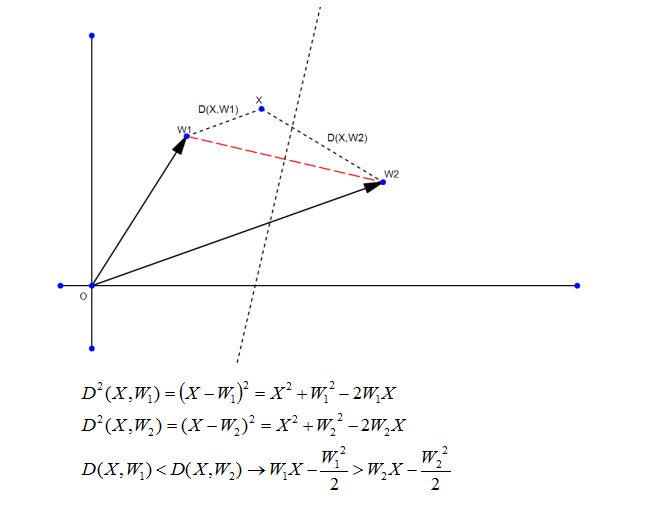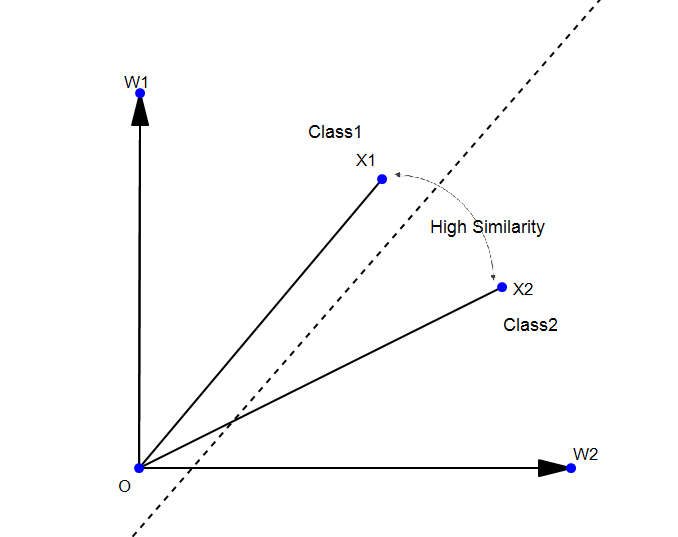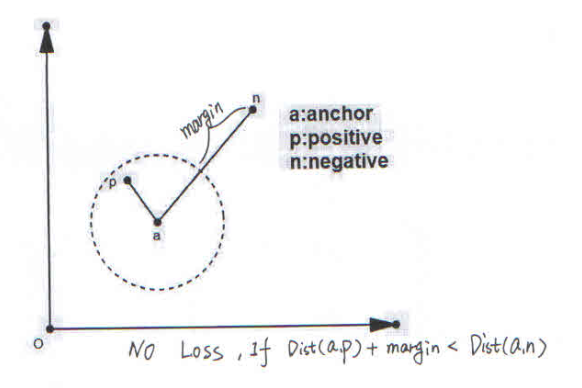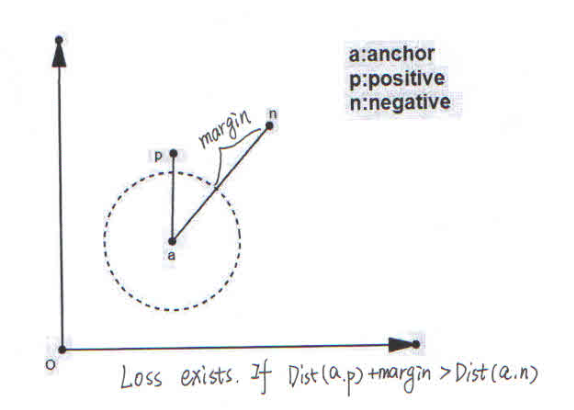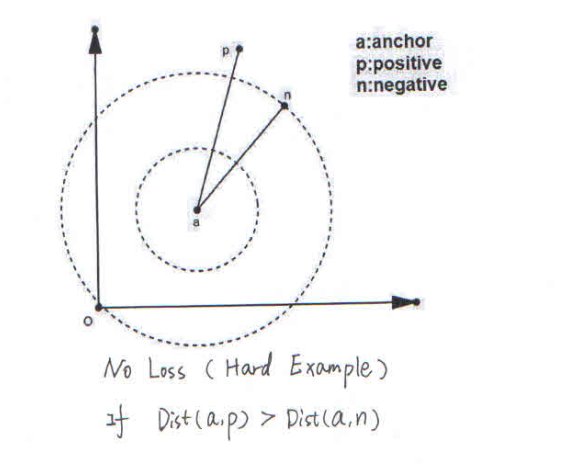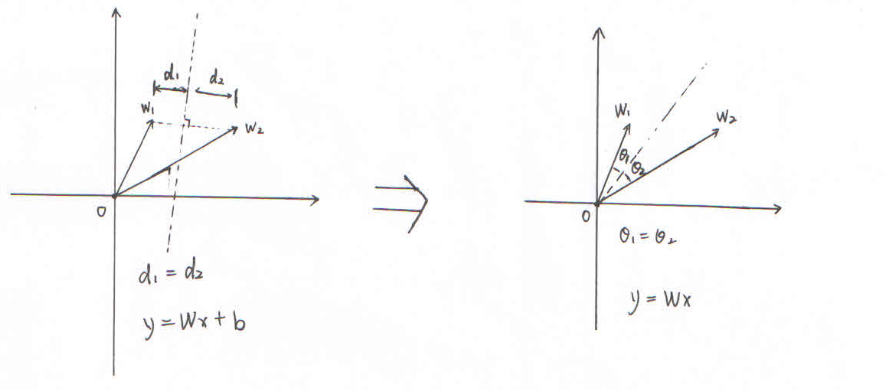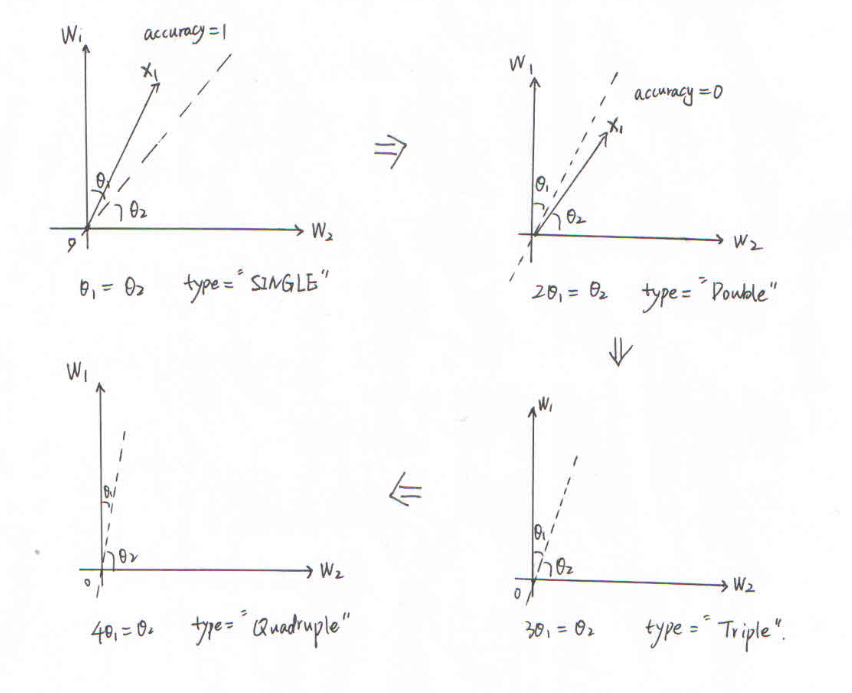=========================================================
中文版
因为英文水平太差难以将**表达出来,所以还是先写一个中文版
想了想还是先把中文版放在前面比较好
前言
在我的第一个project里面,我给出了一种能在大数据集上相对简单的训练sphereface的方法,在issue里面我发现很多人对sphereface的一些现象不理解,我发现face recognition对于初学者来说其实还是比较困难的。所以我打算写一个关于Face Recognition里面关于loss function的一些东西,因为本人是一个非科班出身且仅仅研究了4个月人脸识别的菜鸟,所以说的不对的地方希望大家开issue来使劲喷我(。
分类层
首先说一点关于分类层的一些基础的东西,因为在人脸中,人脸对比的评测目前大多是用余弦相似度来完成的。但是分类层的时候计算的却不是余弦相似度,而是点乘,这一点其实是由线性分类推到而来的,见下图:
其中W表示类中心,X表示样本。
基于分类时与评测时的距离计算方式不同,从而引出了一些关于cosine classification layer以及normface等一系列的论文,感兴趣可以自行查看。
Loss Function
下面介绍一下几种比较有意义的loss function,这几种loss function极大的推动了face recogniton的进程。
softmax
优点
softmax的话大家应该都比较熟悉,作为分类中一种经典的loss function,从分类的prob以及log-likelihood推导而来,其优美的形式保证了反向求导的导数计算的简洁性以及导数处于[-1,1]这样一个区间。
由于softmax是完全基于data distribution的一种产物,所以在大训练集上表现的尤为出色,应该能说是ImageNet时代应运而生的一个完美产物。
缺点
虽然softmax的形式非常优美,但是应用在face recognition上却存在着极大的问题,因为face recognition并不是一个分类问题,而是一个特征提取问题。在人脸比对上是要求余弦相似度的,于是就可能产生下面的情况:
上图中,W1和W2表示类中心,虚线表示分类的分界线,X1和X2分别为类1和类2的样本,可以看到在softmax情况下这两个样本都是成功分类的,但是你会发现这两个样本之间的余弦相似度却很高,这在小训练集(比如CASIA-webface)上非常常见。
Contrastive loss & Triplet loss
经过了softmax的缺点人们终于发现,face recognition想要做的不仅仅是一个分类问题,同时是一个聚类问题。因为直接做分类与聚类很难收敛,所以一般都是先保证分类正确,然后进行聚类。这样就引发了一系列关于metric learning的东西。
Contrasitve loss
对比损失,**与实现都非常简单,我这里也不放loss function的形式了,直接上一张图:
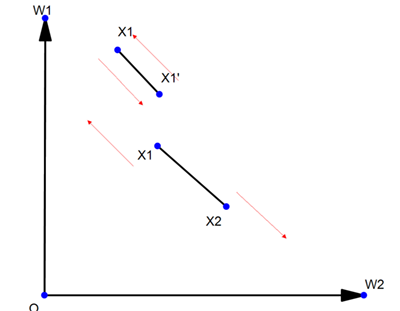
一句简单的话表示就是:两个同类样本尽量接近,两个不同类样本尽量远离,各自的权重都是线性的。
Triplet loss
给个传送门:
https://github.com/davidsandberg/facenet
triplet loss是一个很有趣的loss,与contrastive loss相比,不再是简单的接近远离,而是有了一个明确的目标:
anchor与positive之间的距离一定要小于anchor与negative之间的距离,而且不是简单的小于,是加了margin之后的小于。
具体可以分为下面三种情况:
condition1:Dist(a,p) + margin < Dist(a,n)
condition2:Dist(a,p) + margin > Dist(a,n)
condition3:Dist(a,p) > Dist(a,n)
仔细描述一下:
第一种情况已经满足我们的goal了,所以我们不打算做优化
第二种情况是作者想要主要优化的情况,因为还未满足goal
第三种情况是作者想要直接放弃的情况,因为与goal相差太多,直接当做outlier放弃
与此同时,作者还进行了一些排序操作来进行困难样本处理,这一点就不细说了,想了解的话可以查看github上已经实现好了的triplet loss代码。
缺点 虽然triplet loss做了很多的工作,但是我更愿意把它看成是一个超大数据训练集下的无奈之举。
正如某人所说的,double(contrastive)不如triple,triple不如分类。
这种不基于数据分布的聚类方式(condition1的情况)让其在我心中大打折扣。
Center loss
照例给个传送门:
https://github.com/ydwen/caffe-face
Center loss的目的也很简单,就是想让类内的样本尽量往类中心靠。
那类中心在哪呢?作者给出了一种非常奇怪的方法,通过之前训过的同类样本迭代来更新类中心。
其实我们之前就已经讨论过了,分类层的权重W其实就是类中心,这样来看,作者这样一手操作就显得有点滑稽了(
虽然**简单,但是效果还是不错的,不论是在哪个公开数据集上都能取得相对不错的效果
缺点:
没有什么明显的缺点,用的时候权重分配lambda要选择好,不然就会适得其反,影响softmax的分类效果。
另外,加了个center层保存下来的caffemodel大了一倍,对硬盘不友好
A-softmax loss
传送门:
https://github.com/wy1iu/sphereface
目前来说最满意的loss,但还是有几点不满意的,这些之后再说。
sphereface是由angle margin发展过来的,主要目的是角度约束。
首先要弄懂什么是angle,由前面分类层提到的,点乘其实是欧式距离的一种,而不是余弦距离。为了与测试一致,我们首先要把欧式距离换成角度距离,最为简单的方式就是将偏置项b去掉。
y = Wx+b ---> y = Wx
上图左图是欧式距离,右图则是余弦距离
当然说右边是余弦距离还有点问题,需要保证特征长度固定,这个我们之后再说。
弄懂了angle,然后说下什么是angle margin:
从上图能够清楚地看清两点:
1.类间是如何收缩的
2.type改变,lambda变小之后trainning accuracy为何会下降。
3.在Quadruple下loss为何会维持一个比较大的值
缺点:
sphereface虽然把之前的欧式距离转换成了角度距离加以约束,但是仍然是基于softmax的一种loss,基于softmax的一种缺点在sphereface是表现的尤为突出,可能很少有人会发现这一个对于softmax来说非常非常致命的缺点,只一点表现在为何在训练的过程中loss下降但是整个网络的参数却崩溃的情况。
这个缺点需要阐述的东西比较多,我会在下一个project中详细地说明这个缺点并给出改进的方法。
=========================================================
foreword
In my first Repository: Details-On-Face-Recoginiton I gived an easy way to train sphereface on pretty Large dataset(MS-Celeb-1M).
While responsing Issule I realized that Face Recognition is not a very friendly project for beginners,so in this repository I want to share some experience on Loss Function,which is very hot on recent research.
It's has only been 4 months that I began to learn deep learning and solve the Face Recognition Project.So if you find something wrong in my understanding,please e-mail me or Open an Issue,thanks.
before loss function
why classification layer use dot product?
Do linear classification:
various kinds of loss function
softmax
we all know softmax is a classical loss function for classification,which is based on log-likelihood.
weither you train CASIA-WebFace or Ms-Celeb-1M using softmax,you may easily get an classification accuracy of 1.
But why softmax didn't seem to work good on LFW?
There are two reason:
1.Face Recognition is not a classification question,it's a Feature-Extraction question.We want to make that similarity between the same person is larger that the similarity between different persons.The similirity between twins is very high but they are different person.
2.softmax is based on log-likelihood,so it learns the distribution of the trainning dataset.If you want softmax to work good on test dataset.You may need a pretty huge trainning dataset.It is clearly that softmax on Ms-Celeb-1M is much better than on CASIA-Webface.
Example:
contrastive loss & triplet loss
contrastive loss
contrasitve_loss is to randomly choose two sample from training dataset.If they are belong to the same class,let them get closer;otherwise let then get farther.
contastive loss should be used with softmax.
triplet loss
triplet loss want to achieve a simple goal:
Dist(a,p)+margin<Dist(a,n)
there are three conditions while reaching this goal:
condition1:
Dist(a,p)+margin<Dist(a,n),Loss == 0,nothing need to be change.
condition2:
Dist(a,p)+margin>Dist(a,n),Loss <> 0.a&p should get closer,a&n should get farther.
condition3:
Dist(a,p)>Dist(a,n),Loss == 0 again.triple_loss consider this as a hard sample.
triplet loss is helpful combine with softmax:
But if you think deeper,you'll find that triplet_loss is really not a good loss function.2 reasons:
1.Ignore hard sample,which is not friendly to small trainning set.
2.Loss didn't exist in condition1,which is opposed to the log-likelihood,and this point is unbearable to me.
